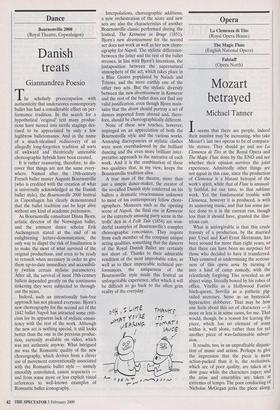Dance
Bournonville 2000 (Royal Theatre, Copenhagen)
Danish treats
Giannandrea Poesio
The scholarly preoccupation with authenticity that underscores contemporary ballet has had a considerable effect on per- formance tradition. In the search for a hypothetical 'original' text many produc- tions have turned into sterile stagings des- tined to be appreciated by only a few highbrow balletomanes. And in the name of a much-idealised rediscovery of an allegedly long-forgotten tradition all sorts of awkward and theatrically untenable choreographic hybrids have been created.
It is rather reassuring, therefore, to dis- cover that things are not the same every- where. Named after the 19th-century French ballet master Auguste Bournonville (who is credited with the creation of what is universally acknowledged as the Danish ballet style), the Boumonville 2000 festival in Copenhagen has clearly demonstrated that the ballet tradition can be kept alive without any kind of academic pretension.
As Bournonville consultant Dinna Bjorn, artistic director of the Norwegian ballet, and the eminent dance scholar Erik Aschengreen stated at the end of an enlightening lecture-demonstration, the only way to dispel the risk of fossilisation is to make the most of what survived of the original productions, and even to be ready to retouch when necessary in order to give them up-to-date immediacy and accessibili- ty (within certain stylistic parameters). After all, the survival of most 19th-century ballets depended greatly on the continuous tinkering they were subjected to through- out the years.
Indeed, such an intentionally fuss-free approach has not pleased everyone. Bjorn's new choreography for the second act of the 1842 ballet Napoli has attracted some criti- cism for its apparent lack of stylistic consis- tency with the rest of the work. Although the new act is nothing special, it still looks better than the one in the previous produc- tion, currently available on video, which was not authentic anyway. What intrigued me was the Romantic quality of the new choreography, which derives from a clever use of movement conventionally associated with the Romantic ballet style — namely smoothly convoluted, canon sequences — and from some more or less explicit visual references to well-known examples of Romantic ballet iconography. Interpolations, choreographic additions, a new orchestration of the score and new sets are also the characteristics of another Bournonville classic performed during the festival, The Kermesse in Bruge (1851). Bjorn's new divertissement for the second act does not work as well as her new, chore- ography for Napoli. The stylistic difference- between the latter and the rest of the ballet stresses, in line with Bjorn's intentions, the juxtaposition between the supernatural atmosphere of the act, which takes place in a Blue Grotto populated by Naiads and Tritons, and the more earthly one of the other two acts. But the stylistic diversity between the new divertissement in Kermesse and the rest of the ballet does not find any valid justification, even though Bjorn main- tains that the divert should portray a set of dances imported from abroad and, there- fore, should be choreographically different.
None of these new touches, however, impinged on an appreciation of both the Bournonville style and the various works. Annoying discrepancies or stylistic clashes were soon overshadowed by the brilliant dancing and the even more brilliant inter- pretative approach to the narrative of each work. And it is the combination of these two qualities that, in my view, keeps the Bournonville tradition alive.
A true man of the theatre, more than just a simple dance-maker, the creator of the so-called Danish style conferred on his ballets a dramatic vivaciousness unknown to most of his contemporary fellow chore- ographers. Moments such as the opening scene of Napoli, the final one in Kermesse or the extremely amusing party scene in the trolls' den in A Folk Tale (1854) are won- derful examples of Bournonville's complex choreographic concertatos. They require from each member of the company unique acting qualities, something that the dancers of the Royal Danish Ballet are certainly not short of. Thanks to their admirable rendition of the most improbable roles, as well as to their impeccable technical per- formances, the uniqueness of the Bournonville style made this festival an unforgettable experience, after which it will be difficult to go back to the often grim reality of the everyday.


























































 Previous page
Previous page